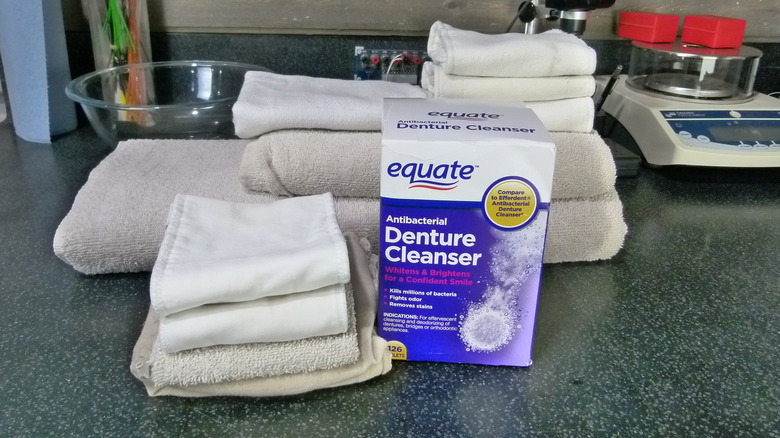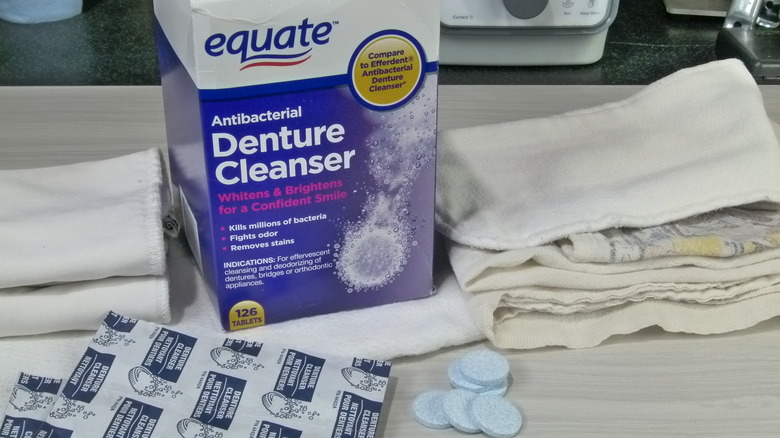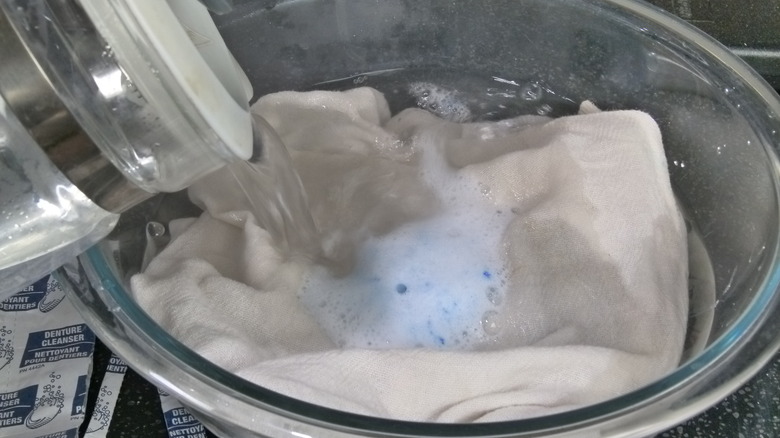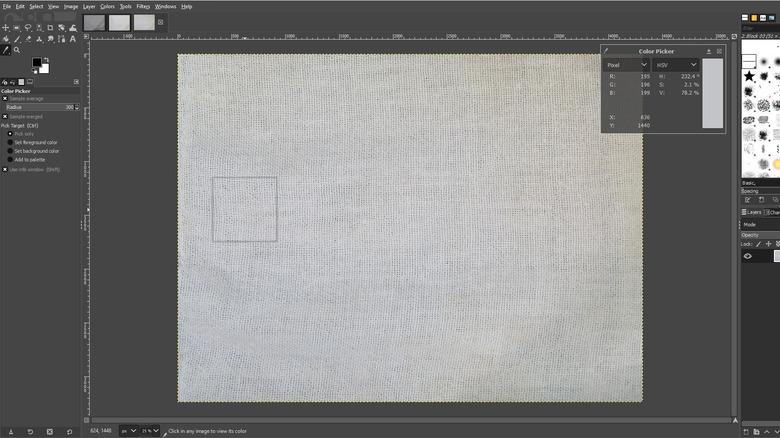We Tried This Easy Denture Tablet Hack For Dull Fabrics And Were Sparkling From The Results
Perhaps desperation caused a grandmother planning canasta night to dip her doilies in denture cleanser to remove the last traces of Agnes' spilled sherry. (We surmise she was out of baking soda, vinegar, and hydrogen peroxide – all of which can be used to brighten whites.) These are the lengths we sometimes go to because we like our whites white. Like, really white. Some manufacturers even add blue to products like white fabrics and marshmallows (yes, some marshmallows have blue food coloring in them) to trick our brains into thinking the whites are whiter than they are. We tried this hack after hearing about it on TikTok, and it did take a bite out of yellowing and stains.
CleanTokker Carolina McCauley claimed it would make your whites "extra bright," and other social media users are known to reach for denture-cleaning products for various laundry and cleaning tasks. We didn't think for a minute that all those folks could be lying through their teeth, and after some investigating, it became clear why this is the most sure-fire laundry hack around. But we'll come back to that.
First, we had to sink our teeth into what we were trying to accomplish. Some TikTok users like Chantel Mila employed this trick to deal with specific stains, while others (like Cecil S) were aiming for brighter towels, t-shirts, and the like. So we figured we'd have a go at both uses.
Preparing to test the laundry hack
After comparing ingredient lists, we bought a box of 126 Equate denture cleaning tablets from Walmart for $3.97. Based on social media posts, the number of tablets required to whiten your laundry varies from one to three. So we figured 126 would cover all the white laundry we could do in a day and leave a few for cleaning coffee pots and accommodating the needs of future visitors.
The problem of what to clean was a bit more vexing. We would be looking for a measurable improvement, so our whites had to be noticeably dingy. That was easy enough; a thin kitchen hand towel and another cloth used mainly to wrap fresh loaves of bread had both seen whiter days. It was the stain removal that turned out to be problematic.
Writers are a notoriously messy lot, but it turns out they can have spouses who are extraordinarily fastidious when it comes to laundry, making a stained piece of cloth challenging to locate. In the end, we unearthed a cloth diaper insert with a light stain of some sort. Describing a diaper insert with a "stain of some sort" might seem understated, but keep in mind this was in a stack of 50 or so completely stain-free inserts. Indeed, a stain that was tough enough to survive such a laundry regime ("motor oil," some speculated; "taco night," claimed others) was not to be taken lightly.
Testing our dingy laundry
McCauley's instructions call for hot water, so we heated a kettle to 92 degrees Celsius (it has no Fahrenheit readout, perhaps for a European market or in preparation for our future AI overlords). Hot water, not always ideal for laundry, is necessary to dissolve the tablets fully. We soaked the items for at least one hour, along with three denture tablets each. These were slightly fizzy and tinged blue by two added food dyes. One theory about the blue dye is that it simply shows the product is working. Another explanation, of course, is that it serves the same function for dentures that laundry bluing does for white shirts.
The ingredients list also includes a vague item called "flavor." The presence of corn syrup solids and sorbitol suggests it might be there to mask the taste of other ingredients on insufficiently rinsed dentures. Luckily, everything tasted normal after soaking our laundry and completing a quick cycle using our washing machine and dryer.
To quantify improved whiteness, we took before and after photos using the same studio, photography lights, camera, and distance. These photos were imported into the open-source GIMP (GNU Image Manipulation Program) software, where we sampled four separate 300x300-pixel areas for each piece of fabric, averaging their brightness values (using the HSV color model).
Should you use denture tablets to whiten laundry?
The reason this was a foolproof hack became evident when we compared the ingredients to those in common laundry products. Most of the tablets' 16 ingredients are commonly used to manufacture laundry cleaners, so denture tablets essentially are laundry cleaners. (One of these chemicals is Potassium Persulfate, an inorganic salt that the Environmental Working Group rates a 6 out of 10 on its hazard scale when used around the mouth. As such, the flavoring and sweeteners might be ill-advised.)
Fortunately, we weren't using them for dentures. And all told, they did an admirable job with our laundry. The most significant effect was on the hand towel, which saw a 22.525% increase in brightness. The diaper insert had almost no improvement in brightness (.775%), but its stains were gone. We detected only a hint of blue in the one fabric we checked; it picked up slightly more blue than red or green, but so little as to be within the margin of error and probably not perceptible.
Ultimately, this hack seems useful for brightening laundry in a pinch and is a reliable tactic for day-to-day stain removal. Of course, it might be made redundant by the right combination of laundry detergents and oxidizing additives. But, for the same reasons, it might also make those cleaners unnecessary, allowing you to have brighter whites without harsh cleaners that set your teeth on edge.



